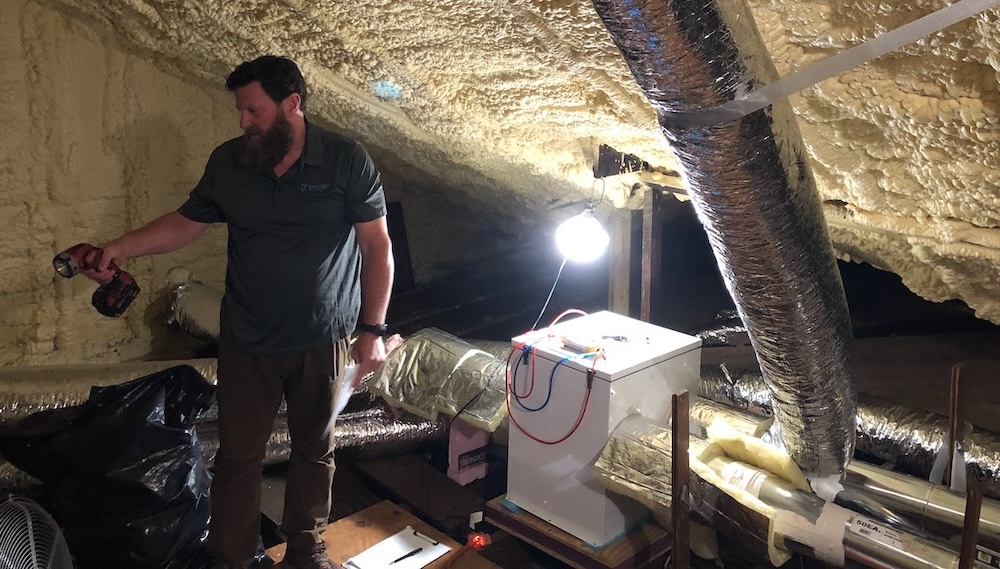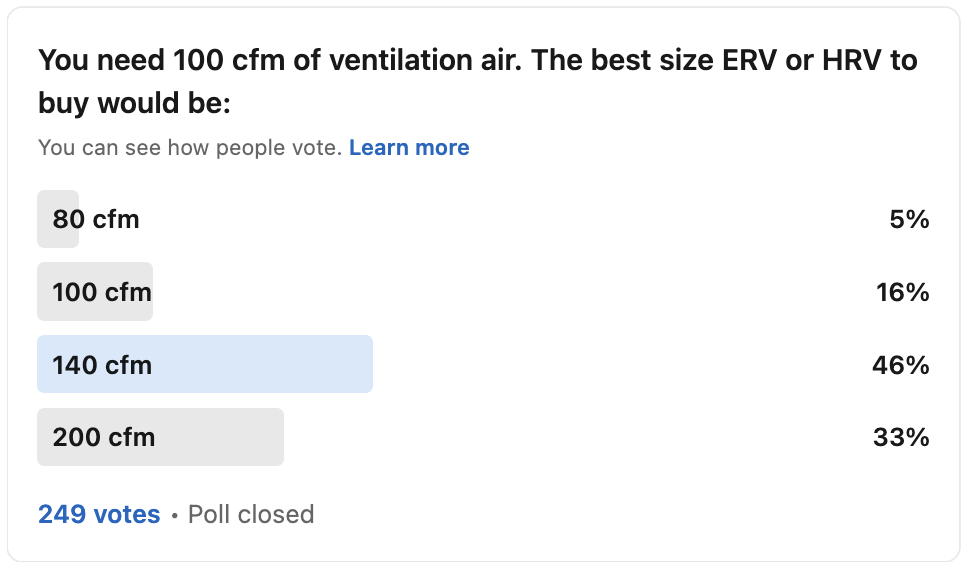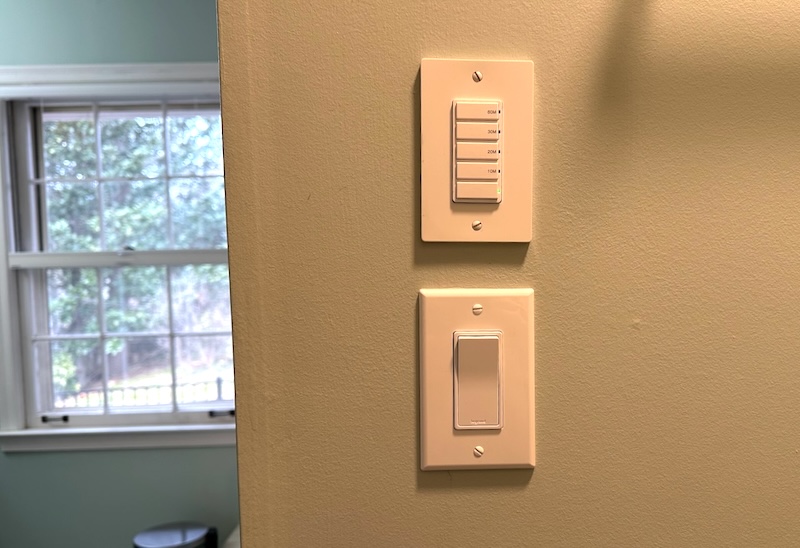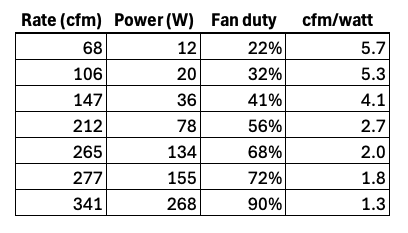How to Size an ERV or HRV

Let’s say you’re faced with the decision of sizing an energy recovery ventilator (ERV) or heat recovery ventilator (HRV). You’ve already decided you’re going with a balanced ventilation system with either heat and moisture recovery (ERV) or just heat recovery (HRV). And let’s say you’ve already figured out what your continuous ventilation rate is going to be. If, say, you’re looking to ventilate at 100 cubic feet per minute (cfm), what size ERV or HRV should you install?
Here’s a LinkedIn poll I did on this topic last month. Which do you think is the best answer?

Low, spot on, or high?
If this were an air conditioner or heat pump, the answer would be low or spot on. That’s because Manual J heating and cooling load calculations result in calculated loads that are larger than actual loads. So at worst, you want to size to what the calculated load is. (I’ve undersized my own heat pump and it works just fine.) Does that hold for ventilation, too?
Or should you go to the high side? Going higher than the air flow rate you actually want isn’t the same as oversizing a heat pump or AC. Oversizing a heat pump or AC would have some negative consequences on comfort and humidity control. Would oversizing an ERV or HRV also have drawbacks?
3 reasons to go high
Actually, choosing an ERV or HRV air flow rate higher than the required continuous rate has significant benefits. In the ventilation designs we do at Energy Vanguard, we look for equipment that can move air at twice the continuous rate.
And there’s your official answer to the poll. Well, it’s our official answer anyway. The 33 percent who chose 200 cfm for an ERV that’s going to run continuously at 100 cfm had the best answer. But why?
1. Boost. The first reason to go with equipment that has a higher capacity than you need for continuous ventilation is so you can boost it when you need more. Not all ERVs let you do this, but it’s a great feature. I recently installed a Zehnder ERV in my house and can boost it by pushing a button.

That’s a great way to get extra ventilation when you need it. It’s also necessary if you want to eliminate the exhaust fans from bathrooms.
2. Efficiency. The second reason to go big is for efficiency. If you’ve done research, you know that ceiling fans are more efficient at lower speeds. It’s the same with other fans. (Actually, it’s called efficacy, not efficiency, but I’ll let you decide whether you want to go down that rabbit hole.)
Here are some data I gathered while writing this article. I ran my Zehnder ERV at different air flow rates and looked at the power usage.

The column on the right side shows the efficacy in terms of cfm per watt. As I turned up the fan speed, that quantity decreased significantly. That’s why I say you’ll see an efficiency benefit by having your continuous ventilation at less than maximum speed.
But there’s more! What I said above applies only to the efficiency of moving air. The efficiency of heat and moisture exchange also improves when you run at less than full speed. I’ll dive into that topic in a future article.
3. Flexibility. Finally, having double the capacity you need allows you adjust your continuous rate to a higher rate. Choosing a ventilation rate can be tricky, so it’s good to be able to have the flexibility to adjust your air flow rate up or down. Of course, reducing the air flow rate is easy even if you chose a 100 cfm ERV to run continuously at 100 cfm. But if you’re already maxed out at 100 cfm, going higher is impossible.
Wrap-up
The bottom line here is that if you’re sizing an ERV or HRV, go big. Doubling the maximum air flow rate from what you need for continuous ventilation gets you the benefits above. But you also have to pay attention to the specifications of the ERV you’re buying. Not all of them have the capability to run at different speeds or go into boost mode. So you have to do your homework. But now you know that going bigger is better.
Allison A. Bailes III, PhD is a speaker, writer, building science consultant, and the founder of Energy Vanguard in Decatur, Georgia. He has a doctorate in physics and is the author of a bestselling book on building science. He also writes the Energy Vanguard Blog. For more updates, you can follow Allison on LinkedIn and subscribe to Energy Vanguard’s weekly newsletter and YouTube channel.
Related Articles
Why You Probably Need an ERV, Not an HRV
We Need Higher Ventilation Rates. But How High?
How Energy Efficient Is Your Ceiling Fan?
Comments are welcome and moderated. Your comment will appear below after approval. To control spam, we close comments after one year.

You discussed fan efficacy at different airflow rates, but what about the heat exchanger effectiveness? Doesn’t that vary with airflow rate?
Roy: Yes, that’s better, too, and I meant to put that in there. I’ll add it now. Thanks!
Thank you for the post Allison. The CDC recommends that commercial buildings have five air changes per hour to maintain good indoor air quality – and I BELIEVE code minimum is 3 ACH for commercial buildings. I realize that this does not apply to the residential world but would love to hear your thoughts on how many continual ACH we might shoot for for residential – I did not see your article suggest a number. But NICE TO SEE people talking about continuous ventilation! And continuous filtration as well.
I strongly believe in it – though I still get many blank stares from building professionals when I ask them what their targeted continuous ACH numbers are. Even so called “experts” on LinkedIn say “no Charles, the ACH test is just done BEFORE the house is occupied – that’s the only time we look at that.”
Charles: There’s another part of that CDC recommendation, though. They include the air being filtered through air handlers and also air treated by ultraviolet germicidal radiation (UVGI). The total of those three, they say, should be 5 air changes per hour.
I didn’t suggest a number here because I don’t think there’s a formula that works everywhere all the time. If I go by what the ASHRAE 62.2 residential ventilation standard says for my house and take “credit” for my infiltration, I need something like 13 cfm.
I started my ERV at 200 cfm, though, because infiltration is intermittent and seasonal. On days with low temperature differences and little wind, the infiltration at my house is very low. Even on cold winter days, the CO2 level in my bedroom can go over 1,000 ppm at night when the door is closed.
I’ve since dropped my ventilation rate and am running it at 150 cfm at night and 100 cfm during the day with an occasional boost during the day.
Thank you Allison – so for the volume of your home, what does that translate to for ACH?
At 150 cfm and ~35,000 cubic feet of volume (including the encapsulated attic and crawl space), that translates to ~0.25 air changes per hour. But we’re getting a lot more air going through our MERV-13 filters in the three ducted air handlers.
I would add a 4th reason – that is duct loss. Most ERV fans are not good at overcoming line loss. Since most installers are using flex duct and running lines to 3 or more supply ports and 3 or more exhaust ports, there are quite a few elbows, tees and termination ports to deal with. I think I chose 140 CFM as my answer but for all the reasons you state I would not disagree that 200 CFM is even better. Thanks for another great article, Allison. JO
John: Excellent point. That should be in there, too. Running at a lower air flow rate in a bad duct system helps the air move more efficiently and quietly. The trick is getting the installers to put in ducts that they think have to move more air than will actually be going through the ducts most of the time.
How does your ventilation rate compare to what is prescribed in ASHRAE 62.2?
Roy: It’s way higher. If I go by what the ASHRAE 62.2 residential ventilation standard says for my house and take “credit” for my infiltration, I need something like 13 cfm.
I started my ERV at 200 cfm, though, because infiltration is intermittent and seasonal. On days with low temperature differences and little wind, the infiltration at my house is very low. Even on cold winter days, the CO2 level in my bedroom can go over 1,000 ppm at night when the door is closed.
I’ve since dropped my ventilation rate and am running it at 150 cfm at night and 100 cfm during the day with an occasional boost during the day.
ASHRAE 62.2 says if the calculated ventilation rate is less than 15 cfm, you don’t need to install a ventilation system. I agree with your comments about infiltration being intermittent depending on weather. Unfortunately, 62.2 assumes good mixing within the house and that average ventilation is what counts. Many people disagree with that.
Boost is absolutely critical!
Cooking events elevate humidity and pollution. They are also when population density in the kitchen and eating area is the highest elevating CO2.
Ideally automating it to boost based on a scheduler or an amp sensor on the range triggering a sequence of operation.
Make sure you have extra capacity for all the reasons Dr. B described above. Once you’ve undersized, you’re undersized.
Aaron: Yeah, if you’re going to spend the money on a whole-house balanced ventilation system, you might as well spend a little more to get one that can do boost and run on a schedule. The Zehnder app allows me to set up a schedule, so I’m currently ventilating at 150 cfm at night and 100 cfm during the day with an occasional boost during the day.
My wife and I used to host a Bible study in our home. 12-15 extra bodies brought CO2 levels >2500 in under an hour! We live in a Step 4 house, not quite PH. High performance construction is a double edged sword….
If the homeowner is social… or has nine kids – you can safely throw the ASHRAE guidelines out the window and use common sense.
Thank you for the great article.
We are building a new house and want to try out an ERV system. My wife wants it to have an integrated PM 2.5 pollution filter, would that be possible as a “pre-filter” without hurting the cfm too much?
Josh: Yes, as with heating and cooling systems, you’d just have to get it sized appropriately for the air flow. See this article I wrote:
The Path to Low Pressure Drop Across a High-MERV Filter
https://www.energyvanguard.com/blog/path-low-pressure-drop-across-high-merv-filter
Okay, here’s a dumb question: When you look at a manufacturer’s product data for ERV capacity, say it says capacity = 600 CFM. Does that mean it has the capacity to SUPPLY 600 CFM of outdoor air, or is that adding the outdoor air and exhaust air together, i.e. 300 CFM outdoor air + 300 CFM exhaust air?
Rob: As far as I know, ERV manufacturers report a number that applies to each air stream separately, not the total. So if it said 600 cfm, that would 600 cfm exhaust and 600 cfm supply.
Allison,
Are you going to play with some sort of pre-filter to help extend the lifespan of those always out of stock Zehnder filters?